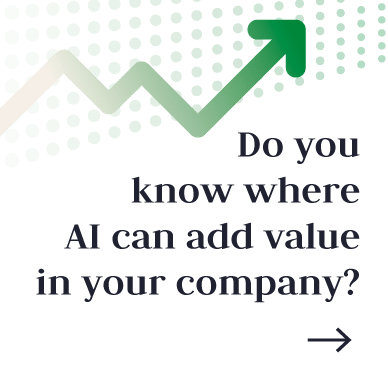“AI” has become somewhat of an umbrella term for technology areas that have something to do with AI, even if it is more specifically Machine Learning or Deep Learning. You will therefore also come across the very general term “AI technologies” in our communication.

At Ambolt AI we work with four technology areas: Computer Vision, NLP (Natural Language Processing), Machine Learning and Advanced Analytics.
Computer Vision is an area of AI dedicated to understanding the visual world. Using images and video, we train deep learning models to recognize and classify objects. We use Computer Vision for e.g. automatic quality control.
NLP (Natural Language Processing) is the area of AI that deals with the interaction between computers and language, i.e. a computer’s ability to understand and process spoken and written language (Natural Language).
Machine Learning (ML) is an area of AI dedicated to automatically finding patterns and relationships in data. We build ML models that, based on historical and new data, can be integrated into microservices for various purposes. Machine Learning will often be involved in Computer Vision, Advanced Analytics and NLP projects.
Advanced analytics tools enable you to correlate data from different systems, find new patterns and correlations, and get an overview of your data through visualizations and statistics.
AI is well on its way to being integrated into more or less all new software versions, but if you have an older system or a number of different systems, you still have the opportunity to benefit from AI. Creating an overview and knowledge across data sources and IT systems is precisely the strength of AI.
In a way, AI technologies can be described as “add-ons” to other systems such as the ERP systems. This is how we are used to thinking of WMS systems working with an ERP system, for example. In the same way, you can set up a microservice to work with existing IT systems. The difference between a microservice and, for example, a WMS system is that the microservice is not a finished product – it is developed for a very specific task.
Regardless of whether large or small AI solutions are needed to solve a task, the strength lies in the fact that it can be designed as an “add-on” to existing IT environments and thus add value without having to replace all systems.
Data Analysis and Insights:
Analyze large amounts of data to uncover patterns and trends. This can provide valuable insights into business processes, customer behavior, supply chain and market conditions, supporting strategic planning and faster response to market changes. Furthermore, different business scenarios can be simulated, helping to understand potential opportunities and risks.
Automating manual processes:
Automate manual tasks, freeing up employee resources for more value-adding activities. This could be digitizing paper documents and automating data entry, or replacing macros in Excel, reducing human error, and increasing efficiency.
ESG and other forms of reporting:
Help with ESG and other forms of reporting by automating the collection and analysis of large amounts of data and automatic report creation. This can save time and reduce human error, as well as enable more accurate and consistent ESG reports.
Improving processes in sales:
Automate and optimize sales processes, make customer management more efficient, and offer personalized customer experiences based on data-driven insights. With an “AI assistant” throughout the entire process, from an enquiry being routed to the right department/employee, to efficiently managing and prioritizing quotes and follow-up, transparency and value is added to sales efforts.
Improve customer service with intelligent automation:
AI-powered chatbots and customer service tools can handle queries efficiently, learn from interactions and continuously improve their ability to meet customer or employee needs. This leads to faster and more accurate customer support. If you have a Microsoft Azure environment, you already have a good starting point for creating an internal chatbot, where you are in control of the data.
Resource optimization:
Through automation and optimization of processes, AI can contribute to a significant optimization of operational costs. This includes optimizing resource consumption, improving energy efficiency, and minimizing waste.
Advanced planning in logistics and production:
Optimize logistics and production processes by, for example, predicting supply needs, optimizing routes, inventory management and production. Advanced planning can be implemented by running a digital twin of the physical world, simulating relevant parameters to optimize.
Quality control:
Quality control, where you need to visually check each product, or ensure other forms of consistency such as sound, can be automated. Visual quality control can be done with computer vision and algorithms that are trained to recognize when quality is within or outside of defined thresholds.
Improving maintenance:
By using predictive analytics, AI can identify maintenance needs to prevent machine breakdowns and perform maintenance at the optimal time, further increasing efficiency and reducing costs.
As the above examples show, the possibilities with AI are endless. The input is data, and the output can be anything from automating tasks and processes and, to deep insights and decision support.
Automation of tasks will usually be a combination of AI and human effort, where the “AI assistant” does the mundane work and the employee performs supervision and decision-making.
© Ambolt 2023 All Rights Reserved